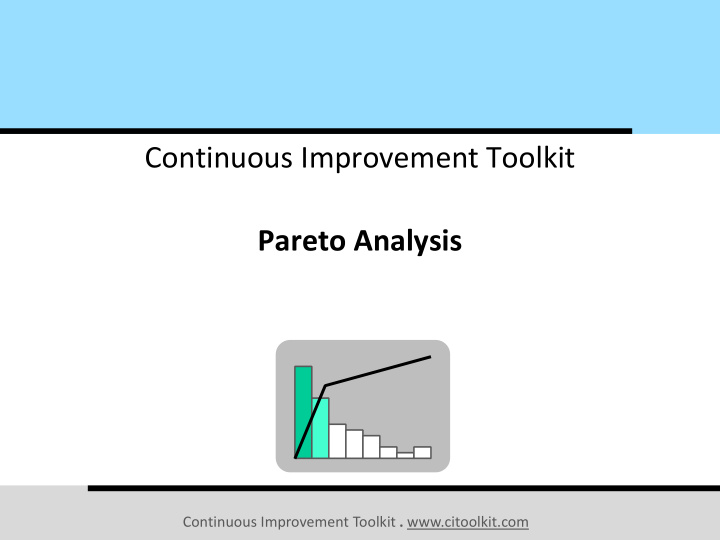



Continuous Improvement Toolkit Pareto Analysis Continuous Improvement Toolkit . www.citoolkit.com
The Continuous Improvement Map Managing Deciding & Selecting Planning & Project Management* Risk PDPC Decision Balance Sheet Importance-Urgency Mapping Daily Planning PERT/CPM RAID Log* Force Field Analysis Cost Benefit Analysis FMEA MOST RACI Matrix Activity Networks Break-even Analysis Voting TPN Analysis Risk Assessment* SWOT Analysis Stakeholder Analysis Decision Tree Pick Chart Four Field Matrix Fault Tree Analysis Project Charter Improvement Roadmaps Critical-to Tree QFD Portfolio Matrix Traffic Light Assessment PDCA Policy Deployment Gantt Charts DMAIC Paired Comparison Matrix Diagram Kano Analysis Lean Measures Kaizen Events Control Planning Prioritization Matrix Pugh Matrix Cost of Quality* Bottleneck Analysis** A3 Thinking Standard work Document control C&E Matrix Pareto Analysis OEE KPIs Implementing Cross Training Understanding Process Yield ANOVA Chi-Square Descriptive Statistics Solutions** Cause & Effect Value Analysis Capability Indices Probability Distributions Hypothesis Testing Ergonomics Mistake Proofing Design of Experiment Gap Analysis* Multi vari Studies Histograms & Boxplots Automation Simulation TPM Confidence Intervals Reliability Analysis Graphical Analysis Scatter Plots Pull Flow Just in Time Correlation Regression Understanding MSA 5 Whys Run Charts Visual Management 5S Root Cause Analysis Performance Data Snooping Control Charts Quick Changeover Fishbone Diagram Tree Diagram* Waste Analysis Benchmarking** SIPOC* Time Value Map Sampling Morphological Analysis Process Redesign Data collection planner* How-How Diagram** Value Stream Mapping Brainstorming Spaghetti Diagram Check Sheets SCAMPER** Attribute Analysis Interviews Service Blueprints Flow Process Charts Affinity Diagram Questionnaires Relationship Mapping* Focus Groups Data Flowcharting IDEF0 Process Mapping Mind Mapping* Lateral Thinking Observations Collection Creating Ideas Designing & Analyzing Processes Suggestion systems Continuous Improvement Toolkit . www.citoolkit.com
- Pareto Analysis The Pareto Principle: Also referred to as the 80-20 rule. States that 80% percent of the problems or effects come from 20% of the causes. Focuses on identifying the ‘ vital few ’ from the ‘ trivial many ’. Helps focusing on what really matters. Continuous Improvement Toolkit . www.citoolkit.com
- Pareto Analysis The Pareto Principle: The exact percentages may vary in each situation. However, most of the activity is caused by relatively few of its factors. 20% 80% Continuous Improvement Toolkit . www.citoolkit.com
- Pareto Analysis Examples: 20% of car drivers cause 80% of the accidents. 20% percent of workers do 80% of the work. 20% of a company’s clients are responsible for 80% of its revenue 20% of the time spent on a task leads to 80% of the results. 80% of the customer complaints come from 20% of customers. 80% of the wealth belongs to 20% of the population. 80% 80% 20% 20% Effects Results Causes Efforts Continuous Improvement Toolkit . www.citoolkit.com
- Pareto Analysis The Pareto Principle: Used when we have many problems or projects and we want to focus on the most significant ones. • Helps prioritize the improvement opportunities that bring the most value to the business. • Allows to reach a consensus about what needs to be addressed first. Used during improvement projects to focus on the causes that contribute most to a particular effect. Continuous Improvement Toolkit . www.citoolkit.com
- Pareto Analysis The Pareto Chart: A frequency bar chart. The most frequent activities are placed in order from left to right. Normally plots the frequencies of categorical data: • Such as defects and errors. The horizontal axis represents the types of activities: • Such as issues, problems or causes. The vertical axis represents the frequencies of those activities. Continuous Improvement Toolkit . www.citoolkit.com
- Pareto Analysis The Pareto Chart: By arranging the bars from largest to smallest, the vital few activities can be easily addressed to have greater attention. If there are a lot of small or infrequent factors, consider adding them together into an “other” category. 100% You may optionally have 40 a cumulative line above the 80% bars so that the cumulative 30 60% percentages can be read from 20 40% the right vertical axis. 10 20% 0% 0 E C A D B F Continuous Improvement Toolkit . www.citoolkit.com
- Pareto Analysis The Pareto Chart: If the resulted Pareto chart clearly illustrates a Pareto pattern , this suggests that only few causes account for about 80% of the problem. This means that there is a Pareto effect . If no Pareto pattern is found, we cannot say that some factors are more important than others. Continuous Improvement Toolkit . www.citoolkit.com
- Pareto Analysis How to Construct a Pareto Chart: Define the problem. Identify the possible causes of the problem (using brainstorming or similar technique). Collect then record the data. Calculate the frequencies of the identified causes. Draw a vertical bar for each cause or cause group. Sort them by frequency in descending order. Calculate then draw the cumulative percentage line. If you observe a Pareto effect, focus your improvement efforts on those few factors. Continuous Improvement Toolkit . www.citoolkit.com
- Pareto Analysis Example: A factory team has prepared the following Pareto charts to address the rising number of customer complaints in a way management can understand. Type of Customer Complaints Type of Product Complaints Type of Document Complaints 40 20 10 30 15 7.5 20 10 5 10 5 2.5 Info. Invoice Wrong Other Product Docs. Package Delivery Scratch Dent Pin-hole Tear-off HME Other missing error quant. The results suggest that they can solve the majority of the problem by concentrating on the vital few. Continuous Improvement Toolkit . www.citoolkit.com
- Pareto Analysis Further Information: Named after the Italian economist Vilfredo Pareto, who observed that 80% of property in Italy was owned by 20% of the population. Someone should be thinking of the Pareto Principle and apply it to his business and life. He should be asking himself questions such as: what are the critical few wants and needs of the consumer, and what are the critical few measures that indicate the true performance. Continuous Improvement Toolkit . www.citoolkit.com
Recommend
More recommend